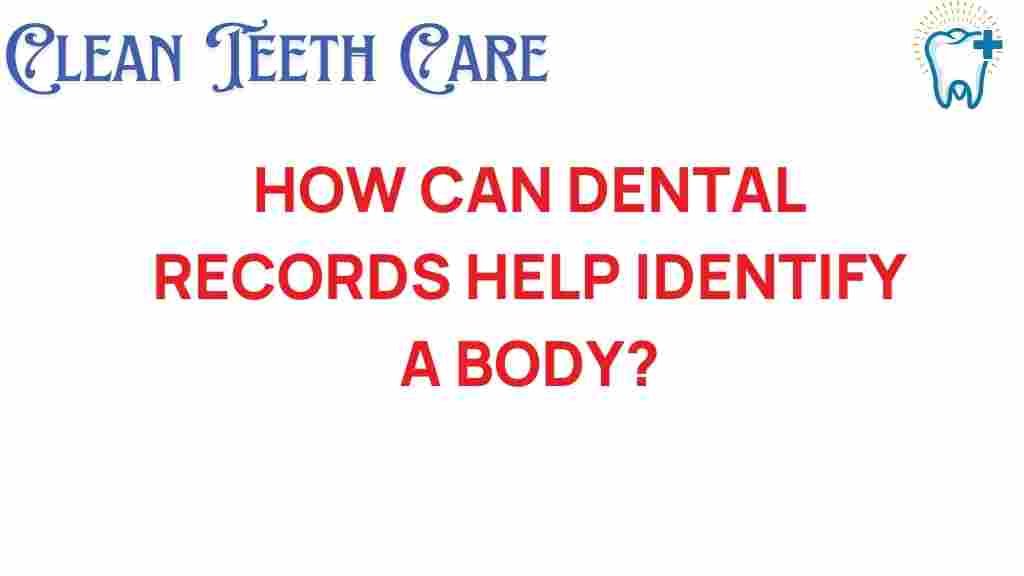Unveiling the Truth: How Dental Records Can Identify a Body
Forensic science plays a crucial role in solving crimes and identifying individuals, particularly in cases involving missing persons or unidentified remains. One of the most underappreciated yet vital tools in forensic science is the use of dental records. This article explores how dental records aid in the identification of bodies, the significance of dental anatomy, and the role of forensic dentistry in delivering justice.
Understanding Dental Records
Dental records are comprehensive documents that detail an individual’s dental history. These records include information such as:
- Dental charts
- X-rays
- Treatment history
- Notes on dental conditions
- Personal identification information
Each person’s dental anatomy is unique, making dental records an invaluable resource for human identification in forensic cases. When a body is found, forensic experts can compare the dental remains to existing dental records to establish a match.
The Role of Forensic Science in Identification
Forensic science encompasses various disciplines, including forensic dentistry. This branch specifically focuses on the application of dental knowledge in legal investigations. The process of identifying a body using dental records involves several steps:
Step-by-Step Process of Identification Using Dental Records
Step 1: Recovery of Remains
The first step in the identification process occurs at the crime scene or location where the body is discovered. Forensic teams work diligently to recover remains, ensuring they preserve evidence for further analysis.
Step 2: Examination of Dental Remains
Once the remains are recovered, forensic odontologists examine the dental structures. They look for:
- Missing teeth
- Dental restorations (fillings, crowns, bridges)
- Unique dental features (such as gaps or irregularities)
Step 3: Comparison with Dental Records
Forensic experts then compare their findings with existing dental records. This comparison includes:
- Matching dental prosthetics with records
- Verifying the presence of unique dental characteristics
- Using X-rays for a more detailed analysis
Step 4: Establishing Identity
If a match is found, forensic odontologists can confirm the individual’s identity. This process can also involve DNA analysis for further verification, especially in cases of severe decomposition.
Step 5: Reporting Findings
Once identification is established, forensic experts compile their findings into a report. This report may be used in legal proceedings to help deliver justice for the deceased.
Challenges in Using Dental Records for Identification
While the use of dental records is a powerful tool in forensic science, several challenges can arise:
- Incompleteness of Records: Not all individuals have comprehensive dental records, especially in cases of transient populations or individuals without regular dental care.
- Decomposition: Severe decomposition can alter dental structures, making identification more difficult.
- Variability in Dental Practices: Differences in dental practices across regions can lead to inconsistencies in records.
Real-Life Applications of Forensic Dentistry
Forensic dentistry has been pivotal in several high-profile cases. Some notable instances include:
- The identification of victims in mass disasters, such as airplane crashes.
- Identifying victims of crime where other means of identification fail.
- Assisting law enforcement in cold cases by re-examining dental records.
These cases illustrate how forensic science and forensic dentistry intersect to provide answers for grieving families and justice for victims.
Importance of Dental Anatomy in Identification
Understanding dental anatomy is essential for forensic odontologists. Each person’s dental structure is shaped by genetics, diet, and oral hygiene practices, leading to unique traits that can aid in identification.
Forensic experts analyze various aspects of dental anatomy, including:
- The size and shape of teeth
- The arrangement of teeth in the mouth
- Any previous dental work or modifications
Forensic Science and Justice
The ultimate goal of using dental records in forensic science is to achieve justice. By accurately identifying individuals, families can find closure, and law enforcement can pursue leads to solve crimes.
Forensic dentistry serves as a bridge between the deceased and their loved ones, providing critical information that can lead to the resolution of cases involving missing persons.
Internal and External Resources
For those interested in further exploring the field of forensic science and its applications in human identification, consider visiting this resource for in-depth studies and case examples.
For professionals in the field, the American Academy of Forensic Sciences provides guidelines and updates on best practices in forensic dentistry. More information can be found at AAFS official website.
Troubleshooting Tips for Forensic Identification
In forensic investigations, challenges may arise that require quick thinking and adaptability. Here are some troubleshooting tips:
- Cross-reference Multiple Sources: When dental records are incomplete, consider other identification methods, such as DNA analysis or fingerprinting.
- Consult with Colleagues: Collaborate with fellow forensic professionals to gain insights and alternative perspectives on complex cases.
- Stay Updated: Keep abreast of advancements in forensic science techniques and technologies that may enhance identification methods.
Conclusion
Dental records are a powerful tool in the realm of forensic science, providing critical information for the identification of bodies in various scenarios, particularly in cases of missing persons. The unique aspects of dental anatomy, combined with the expertise of forensic odontologists, allow for the accurate identification of individuals, helping to provide closure to families and justice to victims.
As we continue to advance in our understanding of forensic science, the role of dental records will undoubtedly remain a cornerstone in the quest for truth in the face of tragedy. Emphasizing the importance of maintaining comprehensive dental records can further enhance our capabilities in forensic identification.
This article is in the category Conditions and created by CleanTeethCare Team
